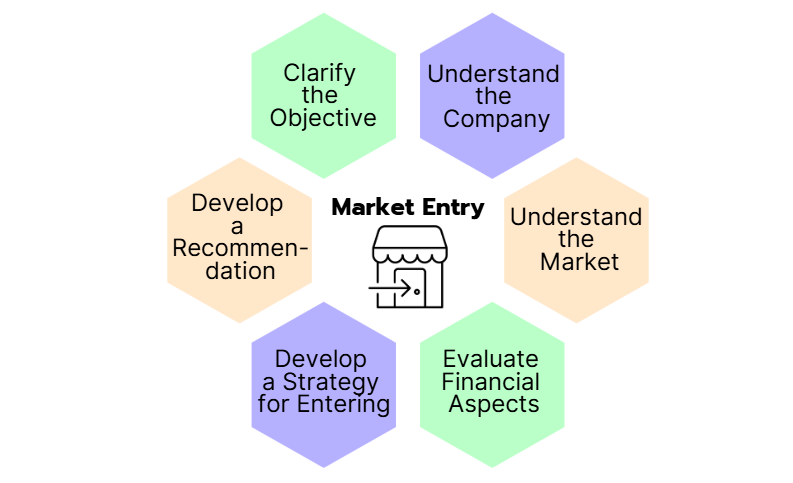Market entry cases are one of the key issues in the consulting industry and present consultants and firms with unique challenges and opportunities. These cases require deep analysis and strategic planning to successfully enter new markets.
Market Entry
Variants of Market Entry Cases
Market entry cases in consulting involve analyzing and developing strategies for a company’s entry into a new market. This includes analyzing the market potential, understanding the competitive landscape and assessing the risks and opportunities. The goal is to recommend the best approach for the company to successfully enter and succeed in the new market.
Market entry cases have two variants:
- Market development: This involves introducing an existing product or service into a new market where the company currently does not operate. This strategy focuses on finding new market opportunities, understanding the local market, adapting the product or service to fit the new market, and using effective marketing and distribution methods to succeed in the new market.
- Diversification: Diversification takes place when a company introduces a completely new product or service into a new market. It is different from market development because it involves offering products/services that may be unrelated to the company’s current products or target markets.
Market entry cases are often hidden in other case types, such as growth or profitability cases. For example, if you are confronted with a scenario in your case interview such as, “Our business model is currently stagnating. What should we do?”, it is imperative to consider various strategic options, including market development or diversification, to revitalize the business and drive sustainable growth.
Use the Following Six Steps to Approach a Market Entry Case
By following these six steps, you can systematically approach market entry cases, conduct a deep analysis and develop strategic recommendations tailored to the client’s objectives and the market. These steps serve as a guideline, but always remember to adapt your recommendations specifically to the company’s case and situation.

1. Paraphrase and Clarify the Objective of the Case at the Beginning.
This first step lays the foundation for the analysis and guarantees that the customer’s expectations are met. In this first stage, it is particularly important that you understand the reasons and background as to why the company wants to enter a new market, whether a market development strategy or a diversification strategy is to be followed and what challenges are involved.
So, when the interviewer presents the case to you, make sure you listen carefully and take detailed notes. Start with paraphrasing the problem and clarify all questions with the interviewer to make sure you understand the problem correctly. Take a minute to structure your thoughts and decide what questions to ask based on the structure. Frameworks such as Porter's Five Forces can help you structure thoughts and systematically identify key information. But always make sure to adapt standard frameworks to the individual circumstances of the case.
2. Understand the Client's Company.
Gain a deep understanding of the client’s business, including its core competencies, products or services, market position and competitive advantages. Understand why the client wants to enter the new market and identify the key issue. Knowing this information will be important in giving a final recommendation.
Important information to determine if the company is ready to enter the target market are:
- What are current revenue streams?
- What are the client's key strengths, weaknesses, opportunities and threats? (SWOT-Analysis)
- What is the product mix? How many and what types of product lines, brands, variations of products does the company have? What is the lifecycle of each product? Also, how closely related are the current products?
- Who are current customers, and how are they segmented?
- What are the current distribution channels?
- What is the client's current financial situation?
3. Understand the Market of Interest.
Understand the market the client wants to enter and evaluate its attractiveness. Using a structured approach, you can gain a deep understanding of the market, identify opportunities and risks, and develop strategic recommendations tailored to your client's needs. To analyze the new market, the following steps may be a useful guideline:
- Estimate the Market Size: If available, start by estimating the market size if that information is available. If not, be prepared to calculate the market size yourself in such cases.
- Evaluate the Growth Rate: What is the growth rate of the market? Is it expanding rapidly, stable or shrinking?
- Determine the Lifecycle Stage: At what stage of the lifecycle is the market? Emerging, Mature, Declining?
- Identify Customer Segments: Who are the customers in this market? What are their specific needs and preferences?
- Understand the Competitive Environment: Who are the key players in the market? What makes them stand out? What are their differentiating factors? Porter’s Five Forces can help you to analyze the competitive environment and the attractiveness of a market in a case study.
- Analyze Industry Trends and KeyTechnologies: What are current trends in the industry and the market? For example, are there movements towards digital solutions or sustainability? Is there any significant technology driving this market? How quickly is it changing?
4. Evaluate the Financial Aspects of a Potential Market Entry.
In this fourth step, analyze and evaluate the financial impact of entering the target market. By structuring the analysis into costs, revenue potentials, and rate of return, you can provide a comprehensive and organized approach to assessing market entry strategies. This detailed breakdown will help in identifying key financial factors and making informed strategic decisions:
Costs:
- Barriers to Market Entry:
- Investment Costs: Identify initial capital required for market entry.
- Fixed Costs:
- Infrastructure costs: Costs associated with setting up a physical or digital infrastructure.
- Personnel Costs: All expenses that a company has for its employees.
- Variable Costs:
- Production Costs: Costs that vary with the level of production.
- Operating Costs: Daily operating costs, including utilities and operating resources.
Revenue Potential:
- Product Pricing:
- Expected Pricing: Determine the expected sales price of the product or service you want to offer in the new market.
- Sales Volume:
- Expected Units Sold: Estimate the number of units expected to be sold within a specific time period.
Rate of Return and Break-Even-Analysis
- Break-Even Point:
- Time to Break-Even: Calculate the number of years required for the clients to recover the initial investment and start generating profit.
- Rate of Return:
- Understand that money has a different value over time: Evaluate the net present value (NPV) to determine how the changing value of money impacts the investment’s profitability.
- Rate of Return Calculation: Evaluate the expected profitability of the investment, taking into account both the initial costs and the future revenue streams.
5. Develop a Strategy for Entering the Market.
If you decide that entering a new market is a good idea, it is important to develop a strategy for how to proceed. There are generally three ways to enter a market:
- Starting from Scratch: Independently establishing a business in the new market.
- Through a Joint Venture: Partnering with a local company to enter the new market together.
- Through Mergers and Acquisitions (M&A): Taking over an existing company or business in the target market.
By considering these following factors and matching them to the company’s specific goals and circumstances, a well-grounded market entry strategy can be developed for successful entry into a new market:
- Competitive Advantage: Can you apply the same business strategy as in your current market, or do you need to adapt the product, marketing, or even sales channels to reach customers?
- Timing: Can you use a first-mover advantage, or would you rather let the competitors try their luck first?
- Speed of Entry: Define whether you want to test a single store or region, or cover the entire market at once.
- Entry Mode: How much commitment do you want to make? Would it be a simple export strategy, where you can exit easily but have less control, OR a 100% subsidy, where investment costs are high but you also have more control?
- Organizational Structure of the New Branch: Do you want to decide centrally or give the individual country manager a lot of freedom?
6. Develop a Recommendation.
Now that you know the company, the“old” and the "new" market, have successfully done all the analyses and got your answers, summarize them and give a recommendation based on the facts you collected. Don't forget to take another minute to structure your answer but make sure to provide your answer first and then the reasons! Use the Pyramid Principle to formulate a conclusion and appropriate well-grounded recommendations at the end of the interview.
Key Takeaways – What to Consider when Solving a Market Entry Case
- Market entry cases are often hidden in other case types, such as growth cases or profitability cases.
- It is important to gain a deep understanding of the client’s business and the market the client wants to enter and evaluate its attractiveness.
- Analyze and identify the most important financial factors before developing a potential market entry strategy.
- When developing a market entry strategy, tailor it to the company's unique characteristics and objectives.
- Make sure that you present a well-grounded market entry strategy.
- Practice makes perfect: Connect with case interview partners and practice together. You'll get valuable feedback and improve your skills much faster than if you just study on your own. Find numerous case partners on our interactive Meeting Board and get started right away!

